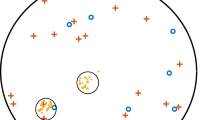Abstract
As one of the most promising techniques for next generation wireless communication, coordinating transmission by multiple points (i.e. radio access points or base stations) have recently attracted a lot of attention because of its potential for intercell co-channel interference mitigation and significant spectral efficiency improvement. This paper firstly presents the system structure and mathematical signal model for multipoint coordinating downlink transmission, and then gives a detailed discussion on dynamical cell-clustering strategies, scheduling utility-metric and resources allocation scheme in adaptively forming cooperation cluster of cells based on detected system parameters, where the user is serviced by a cluster selected from a set of clusters that has been adapted to its particular network circumstance and location. Some numerical analysis shows that with dynamical cell-clustering, a clustered supercell with 7-cell is relatively reasonable for spectral efficiency improvement. Also, some simulation results are given to show that adaptive dynamical cell-clustering methods are more beneficial to user performance improvement.
Similar content being viewed by others
References
Goldsmith A., Jafar S., Jindal N., Vishwanath S. (2003) Capacity limits of the MIMO channel. IEEE Transactions on Information Theory 21(5): 684–702
Serbetli S., Yener A. (2004) Transceiver optimization for multiuser MIMO systems. IEEE Transactions on Signal Processing 52(1): 214–226
Blum R. S. (2003) MIMO capacity with interference. IEEE Journal on Selected Areas in Commununications 21(5): 793–801
Dai H., Molisch A. F., Poor H. V. (2004) Downlink capacity of interference-limited MIMO systems with joint detection. IEEE Transactions On Wireless Commununications 3(2): 442–453
Andrews J. G., Choi W., Heath R. W. Jr. (2007) Overcoming interference in spatial multiplexing MIMO cellular networks. IEEE Wireless Communications Magazine 14(6): 95–104
Andrews J.G. (2005) Interference cancellation for cellular systems: A contemporary overview. IEEE Wireless Communications Magazine 12(2): 19–29
Foschini G. J., Karakayali K., Valenzuela R. A. (2006) Coordinating multiple antenna cellular networks to achieve enormous spectral efficiency. IEE Proceedings-Commununications 153(4): 548–555
Jing S., Tse, D. N. C., Hou, J., Soriaga, J. B., Smee, J. E., & Padovani, R. (2007). Multi-cell downlink capacity with coordinated processing. In Proceedings of the Information Theory and Applications Workshop (ITA 2007), San Diego, USA, January 2007.
Ng B. L., Evans J. S., Hanly S. V. et al (2008) Distributed downlink beamforming with cooperative base stations. IEEE Transactions on Information Theory 54(12): 5491–5499
Brueck, S., Zhao, L., Giese, J. & Amin, M. A. (2010). Centralized scheduling for joint transmission coordinated multipoint in LTE-advanced. In Proceedings of the international ITG/IEE workshop on smart antennas (WSA’10), Bremen, Germany, February 23–24, 2010.
Papadopoulos H. C., Sundberg C.-E. W. (2008) Space-time codes for MIMO systems with non-collocated transmit antennas. IEEE Journal on Selected Areas in Communications 26(6): 927–937
Stefan P., Erik D., Anders F., Ericsson., et al. (2008). LTE-advanced-LTE evolution towards IMT-advanced: Technology components, TSG RAN IMT advanced workshop, REV-080030, Shenzhen, China, April 7–8, 2008.
Further Advancements for E-UTRA Physical Layer Aspects (Release 9). (2009). 3GPP Technical Specification TR 36.814 V0.4.1, February 2009. [Online]. Available: http://www.3gpp.org.
Tse D., Viswanath P. (2005) Fundamentals of wireless communication. Cambridge University Press, Cambridge
Zhang J., Chen R., Andrews J. G. et al (2009) Networked MIMO with clustered linear precoding. IEEE Transactions on Wireless Communications 8(4): 1910–1921
Papadogiannis, A., Gesbert, D., & Hardouin E. (2008). A dynamic clustering approach in wireless networks with multi-cell cooperative processing. In Proceedings of the IEEE ICC 2008, Beijing, China, May 2008.
Spencer Q. H., Swindlehurst A. L., Haardt M. (2004) Zero-forcing methods for downlink spatial multiplexing in multiuser MIMO channels. IEEE Transactions on Signal Processing 52(2): 461–471
Chae, C. B., Heath, R., & Mazzarese, D. (2006). Achievable sum-rate bounds of zero-forcing based linear multi-user MIMO systems. In Proceedings of the 44th annual Allerton conference on communication, control and computing, Allerton House, Monticello, Illinois, September 27–29, 2006.
Weingarten, H., Steinberg, Y., & Shamai, S. (Shitz). (2004). The capacity region of the Gaussian MIMO broadcast channel. In Proceedings of the 2004 IEEE international symposium on information theory (ISIT’04), Chicago, USA, p. 174, June 27–July 2, 2004.
Karakayali K., Foschini G.J., Valenzuela R.A. (2006) Network coordination for spectrally efficient communications in cellular Systems. IEEE Wireless Communications Magazine 13(4): 56–61
Papadogiannis, A., Bang, H. J., & Gesbert, D. (2008). Personal, downlink overhead reduction for multi-cell cooperative processing enabled wireless networks. In Proceedings of IEEE 19th international symposium on indoor and mobile radio communications 2008, PIMRC 2008.
Author information
Authors and Affiliations
Corresponding author
Rights and permissions
About this article
Cite this article
Xiao, Sh. Discussion on Strategies for Adaptive Dynamical Clustering in Cooperative Multi-point Downlink Transmission Systems. Wireless Pers Commun 67, 525–539 (2012). https://doi.org/10.1007/s11277-011-0394-4
Published:
Issue Date:
DOI: https://doi.org/10.1007/s11277-011-0394-4




